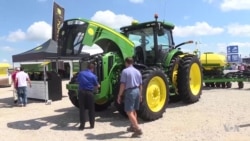Leading measures of U.S. stocks have been setting records. Employment reports are making Americans feel good about the economy.
Yet many farmers in the United States are struggling.
Fertilizer and seed costs are rising at the same time demand and prices for crops are low. And the farmers’ economic problems are affecting others.
The Farm Progress Show is one of the largest events for farmers in the world. It is a place where manufacturers and suppliers can demonstrate their new products and equipment. Farmers go to the show to learn how they can do their work more efficiently.
This year, the show was held in Decatur, Illinois.
Farmer Jeff Fisher went there, but all he could do was look.
The Illinois farmer told VOA he does not have enough money to buy the things he would like to have on his farm. Fisher has not been able to buy new equipment since he last made a profit -- five years ago.
“We’re losing money where the cost of production of corn is higher than the price of corn on the Chicago Board of Trade and our local price.”
The U.S. Department of Agriculture reports median net farm income in 2016 was the lowest since 2009. The department predicts there will be a small increase in earnings this year.
The lack of profit has hurt more than just farmers.
Tamara Nelsen is the Senior Director of Commodities for the Illinois Farm Bureau.
“The Equipment Manufacturers Association released some pretty dismal numbers for farm equipment sales, and what that means to Caterpillar and Deere, that’s troublesome.”
The Association of Equipment Manufacturers reported a 14 percent decrease in farm equipment exports for the first nine months of 2016. Sales dropped 44 percent from 2015 levels in Asia and 28 percent in South America.
Tamara Nelsen says a drop in equipment sales affects manufacturers that depend on farmers buying new equipment.
“If a farmer cannot afford to buy this, then those 25 workers that work to make it and the steelworkers who produce the steel, and all of the people involved in the parts, they are not going to have jobs either -- and so farmers need to have good markets just like manufacturers need to have good markets.”
Mark Bremer is a farmer from southern Illinois.
Bremer grows corn and soybeans on his farm and raises livestock. Like Fisher, he is using old equipment.
“We would love to update, we’d love to purchase new technology and stuff, but that technology comes with a price -- they didn't develop [it] for free.”
Bremer is not sure when he will have enough money to buy new equipment. And he is worried about the effect this year of a lack of rainfall will have on his crops.
“We’re not guaranteed the rain, we’re not guaranteed the price and we’re not guaranteed the yield either so it’s a continual challenge of making it.”
There is also no guarantee that next year will be better. But farmer Jeff Fisher still has hope.
“We’re in the bottom of that roller coaster, it feels like, ride right now -- I hope it doesn’t get worse.”
In a few weeks, he will begin harvesting his crops.
I’m Caty Weaver.
VOA’s Kane Farabaugh reported this story from Decatur, Illinois. Christopher Jones-Cruise adapted his report for Learning English. George Grow was the editor.
We want to hear from you. Write to us in the Comments Section, or visit our Facebook page.
Words in This Story
profit margin – n. the difference between the cost of something and the price at which it is sold
Chicago Board of Trade – n. an exchange or marketplace where agreements on agricultural products are bought and sold
median net – adj. of or related to the middle value
dismal – adj. very bad or poor
livestock – n. cattle or other farm animals
stuff – n. materials, supplies or equipment
yield – n. something produced; a product
roller coaster – adj. of or related to something with numerous ups and downs








